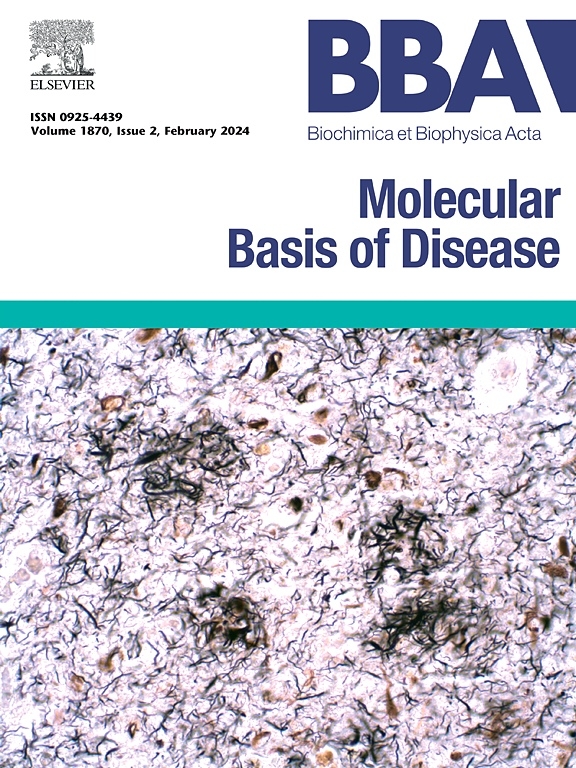对细胞色素c氧化酶缺乏的组织特异性适应形成生理结果。
IF 4.2
2区 生物学
Q2 BIOCHEMISTRY & MOLECULAR BIOLOGY
Biochimica et biophysica acta. Molecular basis of disease
Pub Date : 2024-11-28
DOI:10.1016/j.bbadis.2024.167567
引用次数: 0
摘要
越来越清楚的是,线粒体疾病的组织特异性可能部分依赖于它们补偿线粒体缺陷的能力,从而导致线粒体疾病的异质性。在这里,我们研究了细胞色素c氧化酶(CIV或COX)缺乏的组织特异性反应,使用心脏和骨骼肌特异性COX组装因子COX10缺失的小鼠模型。在三周龄时,两种组织都表现出明显的CIV消耗,但对氧化磷酸化(OXPHOS)损伤的反应不同。心脏特异性COX10缺失导致严重的扩张型心肌病,而骨骼肌受到的损害较小。心脏CIV缺乏引发了广泛的代谢重塑和应激反应激活,潜在地加重了心肌病,而骨骼肌没有表现出应激反应或显著的代谢变化。我们的研究结果强调了不同组织管理CIV缺陷的能力,解释了相同的原发性缺陷如何导致不同的表型结果,并导致线粒体疾病的异质性进展。本文章由计算机程序翻译,如有差异,请以英文原文为准。

Tissue-specific adaptations to cytochrome c oxidase deficiency shape physiological outcomes
It becomes increasingly clear that the tissue specificity of mitochondrial diseases might in part rely on their ability to compensate for mitochondrial defects, contributing to the heterogeneous nature of mitochondrial diseases. Here, we investigated tissue-specific responses to cytochrome c oxidase (CIV or COX) deficiency using a mouse model with heart and skeletal muscle-specific depletion of the COX assembly factor COX10. At three weeks of age, both tissues exhibit pronounced CIV depletion but respond differently to oxidative phosphorylation (OXPHOS) impairment. Heart-specific COX10 depletion caused severe dilated cardiomyopathy, while skeletal muscle experiences less damage. Cardiac CIV deficiency triggered extensive metabolic remodelling and stress response activation, potentially worsening cardiomyopathy, whereas skeletal muscle showed no stress response or significant metabolic changes. Our findings highlight distinct tissue capacities for managing CIV deficiency, explaining how identical primary defects can lead to different phenotypic outcomes and contribute to the heterogeneous progression of mitochondrial diseases.
求助全文
通过发布文献求助,成功后即可免费获取论文全文。
去求助
来源期刊
CiteScore
12.30
自引率
0.00%
发文量
218
审稿时长
32 days
期刊介绍:
BBA Molecular Basis of Disease addresses the biochemistry and molecular genetics of disease processes and models of human disease. This journal covers aspects of aging, cancer, metabolic-, neurological-, and immunological-based disease. Manuscripts focused on using animal models to elucidate biochemical and mechanistic insight in each of these conditions, are particularly encouraged. Manuscripts should emphasize the underlying mechanisms of disease pathways and provide novel contributions to the understanding and/or treatment of these disorders. Highly descriptive and method development submissions may be declined without full review. The submission of uninvited reviews to BBA - Molecular Basis of Disease is strongly discouraged, and any such uninvited review should be accompanied by a coverletter outlining the compelling reasons why the review should be considered.

 求助内容:
求助内容: 应助结果提醒方式:
应助结果提醒方式:


